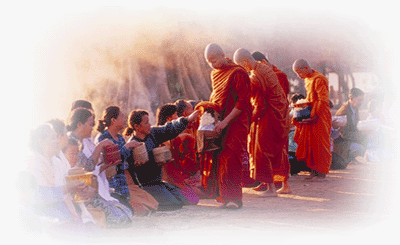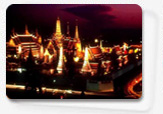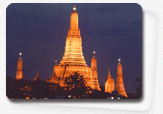
Buddhism: Thai culture - a culture that has survived intact and independent for so long largely because of the principles of the Buddhist faith.
Ninety percent of the population are Theravada Buddhists. The Theravada school of Buddhism is based more purely on the teachings of Gotama Siddartha (Buddha) without the refinements added on by later monks. Buddhist believe that existence is suffering, suffering is caused by desire, so the elimination of desire leads to a state of perfect non suffering and non existence called nibbana (nirvana).
It is non individualistic philosophy which preaches that the suppression and eventual extinction of the ego are the only way to be content. Almost all Thais believe in reincarnation., hopefully to a higher form of life, leading ultimately to the achievement of nibbana. To this end they "make merit" by doing good deeds.
Ways to make merit include giving money to beggars, releasing caged birds and giving food to monkswho do their early morning "alms round", most males will do a spell (although generally only a few weeks) as novices in a temple. This brings merit to the family, and is expected of all boys once they reach the age of eighteen. Within the temple, they will be trained in Buddhist history and philosophy, the paths to enlightenment and the principles of meditation.
There are two sects of Buddhist monks in Thailand, the orange robed Mahanikai and the stricter, more academic red-brown robed Thammayut who can eat only one meal a day (before noon), provided for them by those who wish to make tmerit. They cannot touch money. The services of monks are requested for every occasion. New houses or cars should be blessed to bring good luck nine monks are required for a marriage, and three days of chanting 'mantras' by a group of monks is normal at a funeral.Underlying Buddhism in Northern Thailand is Animism - a belief that all things, such as trees, stones and rivers, have living souls, "Spirit houses" outside all building in Thailand are made attractive to any possibly harmful spirit so that it will not "haunt" the humans living nearby. Buddhism has managed to mould itself onto Animism in Thailand, producing a blend of moral philosophy and superstition. Christianity, introduced recently by missionaries, has gained many converts in the hill tribes. Up to 50% of Karen claim to be Christians. Their legends are very similar to Christianity, and since the Karen may have originate in the Middle East, it is possible that the two religions were once connected. Most hill tribe people, though, are Animist, with some converts to Buddhism and Christianity. Many Yao people, who originated in Southern China, are Taoist, practicing a primitive form of Taoism which was known in China 600 years ago.

There is no such thing as a good Buddhist or a bad Buddhist, viewed in the same context as someone being considered a good or bad Christian. Buddhism, is more of a personal philosophy than a group religion. An individual following the 'middle path', the long road to enlightenment encounters and overcomes the obstacles at his own pace. How good a Buddhist he is, or how far along the path he has traveled, is unimportant to anyone other than himself.
Where Christian religions preach that one must have 'blind faith' in the aspects of the doctrine that you may have trouble accepting, Buddhism teaches that you should 'question everything' until you find an answer that satisfies you.
Buddhism not only teaches tolerance, it practices it. It does not claim that other religions are false, it encourages you to make your own judgments. There is no hard sell, and no requirement for monks to 'save' a quota of souls.

Funeral in Thailand The live of Lord Buddha: In tracing the long life of Siddartha Gotama from birth to enlightenment, and then from Buddha hood to death, one must rely on sources that conjoin fact with fable, legend with history, the myth with the man.
For primary source one turns to the Buddha's own words as recorded in his discourses, to the word of his disciples, and to the Buddhist scriptures. Secondary sources were written several hundred years after the Buddha's death, and often reflect the particular religious convictions of the writer.
To people who, as in the case of Hindus, believed in gods and goddesses, to the animists who believed in spirits, to the Buddhists who believed in celestial beings and the several abodes of heaven and hell, it was only natural to impute to the Buddha supernatural and god-like qualities. He could perform miracles, communicate with the gods, transport himself to heaven, and so on.
And yet there are facts: His birth, his renunciation, his studies with gurus, his period of asceticism, his long period of intense meditation leading to enlightenment, his forty-five years devoted to teaching disciples, his establishment of the Sangha (the world's oldest monastic order),his discourses-these are some of the facts that we know of the Buddha's life.
These facts speak to the mind, the legends to the heart. Together they form a glorious story of a man who twenty-five centuries after his death is revered by millions world wide, not just in Asia, but in ever-increasing numbers in the western world. 
Birth of the Buddha: The birth place of the Buddha - to be was Kapilavastu, now part of Nepal, located close to its southern-most border. Kapilavastu was home of the Sakyas,a small Aryan tribe of the Gotama clan, ruled by his father, Suddhodana. His mother was Maha Maya, splendid, beautiful and steadfast, of the neighboring tribe of Koliya.
the custom of the day, when Maha Maya approached the time for delivery, she wanted to return to her parental home. On their way to Koliya, Maya and her courtiers found themselves in Lumpini Grove, where she suddenly went into labor and gave birth to a son, in what was said to be a painless delivery. She died seven days later, and her younger sister, Prajapati, also wife to King Suddhodana, took on the responsibility of bringing up the child.
Soon after the birth, a sage and prophet named Asita came to see the boy, an declared that he was destined to be either a great king or great spiritual leader. Suddhodana then named his son Siddartha, meaning "he who has accomplished all his aims", and to make sure that he would be a great king and not a great spiritual leader, he resolved to keep the boy always at home, in luxurious, palatial surroundings, with amusements and diversions to keep him happily occupied
Religion in Thailand
Why the Prince Siddartha left the Palace: At the age of sixteen, just after his demonstration of extraordinary martial skills, Siddartha married his first cousin Yasodhara. For the next thirteen years the young prince lived in luxury surrounded by the melodious music of sensuous female attendants, sumptuous food, and every possible pleasure and delight that he could wish for.
At the age of twenty-nine Siddartha Gotama ventured out of the palace grounds for the first time. As he rode forth into an unknown world, his eyes came upon four sights that were to change the course of his world : The first was a old man, his hair was gray, his back bent, teeth broken, supporting himself on a cane and trembling. The second was a sick man, body diseased and infected. The third sight was the corpse of a dead man, and the fourth, a religious mendicant, a Brahmin monk who had left the world and adopted a homeless life in order to seek salvation.
Siddartha enquired of his charioteer, Channa, just what these sights were, and after he was told the meaning of old age, sickness and death, he knew what he must do.
Modern historians and scholars view these "four passing sights" as a way to impute supra mundane happenings to mundane events. The Buddha-to-be may be presumed to have had a sensitive nature, a probing mind, and extraordinary intelligence. By the age of twenty-nine he must have witnessed old age, sickness and death, despite the attempts by his father to insulate him, and he would have been so distressed by these manifestations of human suffering that he would have resolved to seek the cause and the cure.
So at the age of twenty-nine Prince Siddartha Gotama left his world of luxury, foregoing his inheritance and his future ascension to the ruler ship of the Sakyar, his beautiful wife and child, his concubines and worldly pleasures, and went forth to seek knowledge and truth. Buddha ImagesThais are a deeply religious people who considered all Buddhist images extremely sacred-no matter their age or condition. Sacrilegious acts are punishable by imprisonment-even when committed by foreign visitors. The icons, churches, temples and sacred places of any religious group should always be respected by others on their travels. Ignorance is scant excuse. Buddhist Monks: Buddhist monks must also be treated with respect. Monks cannot touch or be touched by females, or accept anything form the hand of a woman. Rear seats in buses are reserved for monks; other passengers should vacate these seats when necessary. Never stand over a seated monk since they should always remain at the highest elevations. 
Temple dress code: All Buddhist temples in Thailand have very strict dress codes, similar to Christian churches in the West. Shorts are not acceptable attire in Buddhist temples-men should wear long pants and a clean short-sleeved shirt. Woman are best covered in either pants or a long skirt, and shoulders should not be exposed. Leather sandals are better than shoes since footwear must be constantly removed. Rubber flip flops are considered proper only in the THBroom, not religious shrines. Buddhist temples are extremely sacred places; common sense dictates that you dress appropriately when visiting any place of worship.
   In Thailand, a temple is much more than a place to worship, The wat is the center of village life, serving as a school, orphanage, theatre, meeting hall, crematorium, youth club, playground - even sometimes a market, political center or restaurant. Although one's behavior must always be correct and polite in a temple, there is no feeling of remoteness or superiority in a Thai wat it is a repository for all aspects of the life and spirit, as well as the spirituality of the community it serves.
Thais love to "make merit" with Buddha by donation religious objects to temples. These are always accepted, which means that temples are cluttered with religious bric-a-brac. The richer the populace the more extensive and impressive the objects donated. Recently, a poor lady won six million baht in the national lottery. She spent all the money on the building of a new temple, so staying poor but making enough merit to assure her of a good reincarnation at her death. Truly a long term investment!.
Although wats are exclusively Buddhist, there are elements of pre-Buddhist, Hindu beliefs in most temples. Hindu gods such as Shiva may have their statues included, and Thais combine Buddhism with ancient Animist beliefs so that temples have become centers of local superstition as well as Buddhism. For many visitors, wats can become too much. Having seen a few, they merge in the mind's eye into an unfathomable riot of strange sculptures and bright colors. 
Without some understanding of the design and function of the various parts, the brain can switch off and "no more temples" is the unfortunate response.
A wat is a complex of several buildings. There is no fixed pattern, but in general the largest and most central building is the wiharn. This building will have one or more Buddha statues at the far end (Buddhas should always face east), before a large open area for the general public. In this area people come to worship, and to receive instructions from the monks. The chief monk ( or Abbot ) may have a special low dias of ornamented wood to the left of the altar area. The walls of the wiharn are usually decorated with murals depicting the life of Buddha. These vary from exquisite ancient depictions to ugly modern ones.
To one side of the wiharn there will usually be one or more chedis. These conical structures of brick, coated with plaster painted white or covered in brass or gold, are said to resemble piles of rice.
When asked at his death how he should be remembered, Buddha replied "Make piles of rice to remember me by". Chedis contain the bones or other relics of religious leaders. The most prestigious (giving the temple the name of Wat Prathat or Wat Mahathat) contain relics of Buddha himself. Many Thais, on cremation have their remains interred into the side of a chedi, identified by a small plaque set into the surface.
The bot is the building where monks are ordained. It may contain the most sacred Buddha sculpture, but is often closed when not in use, and the building may be quite small, tucked away in a corner. The area of consecrated ground is marked by eight black stones around the corners and axes of the bot.
Most temples also contain a library, usually a decorated wooden building raised on a podium, and a sala where novice monks or orphaned children are educated by ordained monks. It is customary to have a bothi tree within the temple grounds. It was under this thick trucked tree with heart shaped leaves that Buddha became "enlightened". To one side of the temple grounds, identified by the saffron robes hanging out of windows, are the monks' quarters. Monks administer, clean and look after the wat, as well as teaching and meditating in it.
All temples are covered in small, highly reflective mosaics of colored glass. Their significance is to drive away evil spirits - if they approach too close they will see their reflection and be frightened away. There are other precautions to ward off bad spirits, including the monster figures often guarding doorways. Many temples are approached by long flights of steps, guarded at the base by pairs of fearsome serpent heads (nagas) whose long scaly backs form the walls on either side of the steps.
The naga is a serpent which can change shape at will. One guarded Buddha in the wilderness by growing seven heads to form an umbrella over Buddha's head, and promised to give his body for use by Buddha for all time. Candle holders near the altar within the wat are normally made in the form of a naga.
Singhas are very popular in Northern Thailand. These are stylized lion statues, and originate in Burmese folklore. They represent strength and power and are usually depicted with mouth half open, seated outside temple door, or devouring a frightened victim. The Kala is a monster that devours itself, representing the relentless passage of time. It is usually shown without its lower jaw, which it has already eaten. Originally a Hindu god, it is often seen above windows and doors.

Kinnari are beautiful women above the waist, but with the wings and legs of a bird. They are companions to the gods, and are Himalayan and Animist in concept. Ornate Kinnari are popular in Chiang Mai temples.
The Hongse is a mythical swan-like creature, the mount of the god Brahma. It is often seen in the Northern Thailand as a decoration for ornamental gates or standing on a tall pole in front of the wiharn.
All temples contain at least one, and usually many, Buddha images. They can be made from a wide range of materials, but are commonly brick based and covered in cement or plaster stucco. Smaller or more venerable statues will be made of molded bronze, brass or gold. In front of the main image in every temple will be an arrangement of offerings, including lotus blossoms covered in a tea cozy like hood of dried flowers, bronze or copper money trees and commonly a host of lesser Buddha statues, donated by worshippers to make merit.
The physical features of Buddha are largely determined by convention. These vary over time and from place to place. All Buddha's though, have certain features in common. There is a lotus bud on the head to symbolize enlightenment, and very long earlobes which show he was of a royal family who wore such heavy earrings that the ears became lengthened. The fingers are, in most styles, of equal length, as are the toes.
Some statues of Buddha are very different. The Chinese favor an obese, potbellied Buddha. One at Doi Tung has a large deep navel in which visitors are invited to toss coins. This Buddha is associated with happiness, wealth, food and plenty. A fine example towers over the food market at Chiang Rai. An emaciated statue refers to Buddha's experiment as an ascetic - when he decided that total self denial was unnecessary, and developed the idea of 'the middle path'.
Buddha may be pictured in number of different poses. Most usually he is seated cross legged, which indicated meditation. If the right hand is raised, palm outwards, this indicates that Buddha is imploring peace. With left hand raised, palm up, he is teaching. If two fingers are held up, he is blessing. If both bands are down, then Buddha has achieved enlightenment.
The reclining Buddha, in which he is seen resting on a cushion with one arm holding his head, refers to the death of Buddha - the point at which he achieved nirvana.
The walking Buddha refers to walking meditation - regarded as very difficult by most monks. Standing with both hands raised, palms outwards, is a sign of power and refers to a legend in which Buddha stopped the sea from engulfing a village by adopting this pose.
All Buddha images are designed according to precise convention. The sculptor has no artistic freedom in which to work. The changes through time Thailand - Religion - Historical Background
Religion in Thailand

|